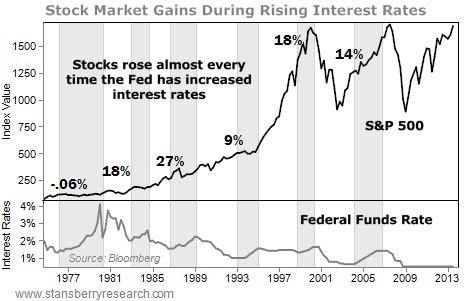| Home | About Us | Resources | Archive | Free Reports | Market Window |
If You're Worried About Rising Interest Rates, Look at This ChartBy
Friday, August 2, 2013
"Don't fight the Fed."
You can hear that phrase on bond-trading desks throughout Wall Street. It's a warning to investors and traders. Don't try to outthink the central bank or anticipate its next moves...
Federal Reserve policies and their effects on the economy are like the movement of a giant aircraft carrier. It takes a long time for the direction and momentum to shift. The ships don't swerve suddenly.
The Fed is the same way. The influence of its monetary policies is pervasive and relentless. If the central bank is cutting rates and trying to juice the markets to keep the economy moving along... you'd better not bet against fixed-income and stock markets.
In my experience, working on the desks of a few Wall Street firms, trying to go against the Fed is a bad trade... You'll lose almost every time.
But... you may ask... what happens when the Fed does begin to shift? We don't want to be caught on the wrong side of any new policy, right?
It turns out, you don't need to lose sleep about that, either. Let me explain...
As readers of my Retirement Millionaire service know, I always base my decisions on the facts. I don't risk my money on speculations or hypotheses. I look deep into what the data tell me is really happening in the market. We make our decisions based on evidence.
So today, we're going to look at the facts surrounding how markets react to Federal Reserve market policy. I assure you the data tell a different story from the one you're likely to hear about "taper risk" and the imminent demise of the "bond bubble."
Let's look at the facts. What would likely happen if the Fed comes out tomorrow and announces, "Great news, the economy is booming and we're raising rates and ending all of our stimulus!" Would that be our signal to run to cash?
Not at all. And here's why...
When an announcement is made that rates are rising – whether it's ahead of the Fed's actual actions or an advance warning – stock indexes like the Dow Jones Industrial Average will take a tumble for a few days, maybe a week. But believe me... they'll come roaring back.
This chart shows stocks for 40 years, essentially my investing lifetime. The shaded areas are the time when the Fed was raising its federal-funds rates. That's the rate it sets for banks to lend each other money. The average gain when the Fed was raising rates was 14%.
 That's not a trade I'd want to miss.
But be thankful that most people don't know that. It makes it easier to benefit from misguided or overblown fears in the stock market. This is why I recommend people stay invested in stocks in their portfolio's asset allocations.
In fact, the U.S. economy continues to grind higher. I don't see evidence that the Fed will declare victory and cut off its bond-buying as soon as some people think. And even if it did, you'd have time to adjust your portfolio before the true effects filtered through the economy... Again, the Federal Reserve's ship does not turn on a dime.
That means a portfolio of well-chosen stocks will continue to perform well. And it means investors should not unload their unleveraged fixed-income positions, either. With a slow-growing economy and minimal price inflation, real returns on almost all securities still look attractive.
My core holdings always include businesses that are shareholder-friendly and that will make money in almost any economic environment. If I can buy sales and cash flow at cheap levels, I want to do that trade over and over...
No matter what the Fed is doing.
Here's to our health, wealth, and a great retirement,
Dr. David Eifrig
Further Reading:
"Once we look at what the numbers are telling us about the economy," Doc writes, "we can start to plan our investments... and our retirements." Last month, Doc showed readers the numbers. They might surprise you... Find them here: A Common-Sense Answer to the Biggest Retirement Worry.
Market NotesAN IMPORTANT REMINDER ON SELLING THE BASICS Today's chart is an important reminder that selling the basics isn't exciting. It just works.
For years now, we've urged readers interested in high-growth emerging markets to "sell the basics." This means owning dominant global firms that sell basic products – like soda, beer, and cigarettes – to these markets.
"Boring" products like these enjoy steady demand... And there's little risk that a new technology will make having a beer after work obsolete. Plus, well-run companies in these industries generate huge cash flows and big dividends.
A "basics" leader we've highlighted many times is Philip Morris International (PM). It's a longtime recommendation of our colleague Dan Ferris. PM is the international offshoot of U.S. cigarette powerhouse Altria. That makes it the largest international vendor of cigarettes... and a direct play on the world's growing middle class.
As you can see from the chart below, not much changes when you sell the basics. Over the past three years, PM has climbed from $50 to $90... and paid steady dividends the whole time. We state again: Selling the basics isn't exciting... it just works.
 |
In The Daily Crux
Recent Articles
|


